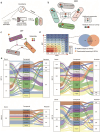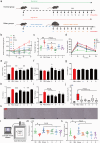Symbiotic probiotic communities with multiple targets successfully combat obesity in high-fat-diet-fed mice
- PMID: 39488738
- PMCID: PMC11540072
- DOI: 10.1080/19490976.2024.2420771
Symbiotic probiotic communities with multiple targets successfully combat obesity in high-fat-diet-fed mice
Abstract
Probiotics hold great potential for treating metabolic diseases such as obesity. Given the complex and multifactorial nature of these diseases, research on probiotic combination with multiple targets has become popular. Here, we choose four obesity-related targets to perform high-throughput screening, including pancreatic lipase activity, bile salt hydrolase activity, glucagon-like peptide-1 secretion and adipocyte differentiation. Then, we obtained 649 multi-strain combinations with the requirement that each must cover all these targets in principle. After in vitro co-culture and in vivo co-colonization experiments, only four (<0.7%) combinations were selected as symbiotic probiotic communities (SPCs). Next, genome-scale metabolic model analysis revealed that these SPCs showed lower metabolic resource overlap and higher metabolic interaction potential involving amino acid metabolism (Ammonium, L-Lysine, etc.) and energy metabolism (Phosphate, etc.). Further animal experiments demonstrated that all SPCs exhibited a good safety profile and excellent effects in improving obesity and associated glucose metabolism disruptions and depression-like behaviors in high-fat-diet-fed mice. This anti-obesity improvement was achieved through reduced cholesterol level, fat accumulation and inhibited adipocyte differentiation. Taken together, our study provides a new perspective for designing multi-strain combinations, which may facilitate greater therapeutic effect on obesity and other complex diseases in the future.
Keywords: Obesity; genome-scale metabolic model (GSMM); multi-strain combination; probiotics; species coexistence; symbiotic probiotic community (SPC).
Conflict of interest statement
No potential conflict of interest was reported by the author(s).
Figures






References
-
- Rodrigues RR, Gurung M, Li Z, García-Jaramillo M, Greer R, Gaulke C, Bauchinger F, You H, Pederson JW, Vasquez-Perez S, et al. Transkingdom interactions between lactobacilli and hepatic mitochondria attenuate western diet-induced diabetes. Nat Commun. 2021;12(1):101. doi:10.1038/s41467-020-20313-x. - DOI - PMC - PubMed
-
- Bender MJ, McPherson AC, Phelps CM, Pandey SP, Laughlin CR, Shapira JH, Medina Sanchez L, Rana M, Richie TG, Mims TS, et al. Dietary tryptophan metabolite released by intratumoral lactobacillus reuteri facilitates immune checkpoint inhibitor treatment. Cell. 2023;186(9):1846–1862.e1826. doi:10.1016/j.cell.2023.03.011. - DOI - PMC - PubMed
MeSH terms
Substances
LinkOut - more resources
Full Text Sources
Medical
